Sony 7600 Series
The Sony 7600 series of radios was an extremely popular and long-lived line of paperback book-sized radios which spanned the years from approximately 1977 – 2018. Under the guidance of Sony Co-founder Akio Morita who was passionate about portable electronics (he later invented the original Walkman), the 7600 series occupied a mid-sized, mid-priced niche and were innovative and of generally high quality. They were great travel-sized radios which were also good enough for in-home use and were good values. There were a few others in the series but for this article I will be discussing four significant models which are interesting because they represent four different time periods with a few seemingly aimed toward users of different wants and priorities…more on that later.
For a complete chronology of the entire 7600 series, I recommend Stephen Grossklass’ excellent Sony 7600 Page:
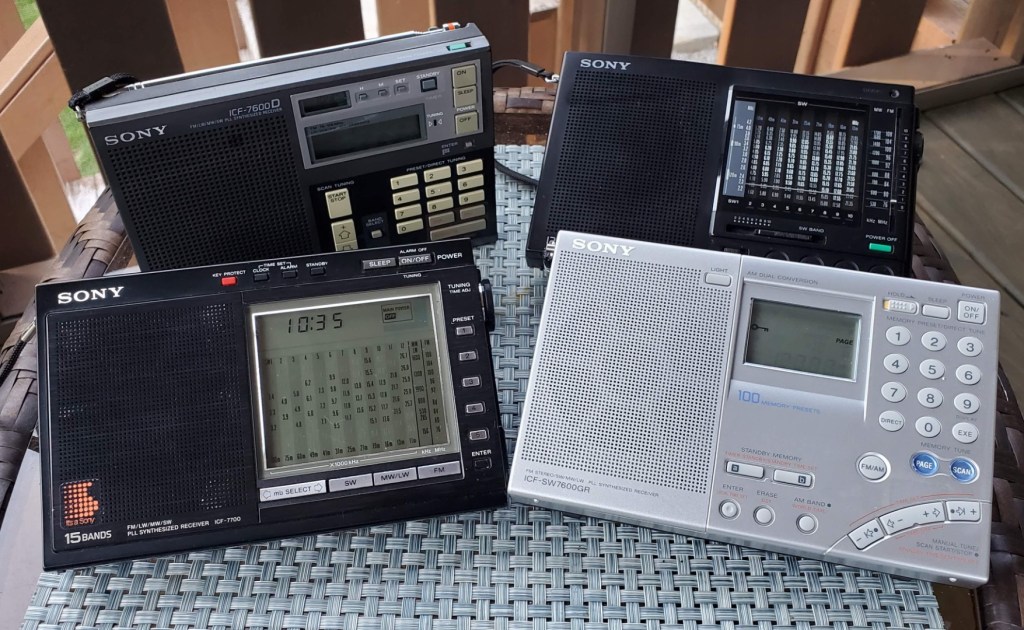
Before we get started, I have to point out that Sony, in an attempt to prevent gray market goods from being distributed here in the US, made different versions for the US which were the same radios as those intended for other markets but with different model designations. Further complicating things some of these model numbers were confusingly similar to completely different models so one has to be careful.
For this article I will be comparing four major models from the 7600 series:
ICF-2002/ICF-2003 (USA) // ICF-7600D/ICF-7600DS – 1983 – 1989 (All similar) ($295)
ICF-7700 (USA) //ICF-7600DA – 1987 – 1989 ($269.95)
ICF-7601 – 1988 – 1990 ($130)
ICF-7600GR – 2001 – 2018 ($180)
Prices are approximate and varied markedly from time to time and place to place.
I grouped the ICF-2002 and ICF-2003 together as they are quite similar with only minor internal upgrades which is also true of the non-US versions – I told you the model numbers would be confusing.
Initial Impressions: As I write this in 2021 these 7600 series radios seem to represent everything that was good about the way radios used to be made. They are solid and heavy with excellent overall performance for their size and era. The fact that most of these radios are still working at their original levels many years later is a testament to their build quality.

The first thing I noted is that I would have guessed the order of manufacture of the first three of these was opposite of their actual introduction dates. The earliest one, the ICF-2002 is a fully digital PLL-tuned, dual conversion radio offering a keypad for direct frequency entry, continuous SW coverage and SSB and represented a breakthrough in features in this category for 1983. The next model chronologically was the ICF-7700 which deleted the keypad in favor of a faux analog dial scale which looked like a traditional analog radio with multiple dial scales. Next was the ICF-7601, introduced in 1988 which reverted to full analog design with no digital features at all, probably to hit a lower price point. It might seem that Sony was swimming backwards with each new model introduction.
Following a few other models, the series ended with the ICF-SW7600GR in 2001 which was the most refined design of the series with the most up to date digital features including Synchronous Detection.
Each Model in Detail: Back in time to 1983, the ICF-2002 was an all-out tour de force of innovation and design, offering breakthrough features and performance in this size category, with a price tag to match. It retailed for $295 which is equivalent to $787 in 2021! Nevertheless, it was a run-away success and with more than 500,000 sold it helped Sony remain a pre-eminent presence in the multiband portable radio market. The ICF-2002was an early model to offer full digital operation with a keypad for direct frequency entry, 10 station memories, PLL, Dual-Conversion, full coverage from 153 to 29995 KHz (in most countries), a Clock with Timer, 5 KHz tuning steps, SSB with a Fine-Tuning thumbwheel and an Aux Antenna input that worked on all bands and disconnected both internal antennas…both rare features even today. You also had a 20 db attenuator switch which could be useful when using external antennas, Record* and Earphone jacks, a DC Input jack and a Music/News Tone switch. The radio also tuned with Up/Down buttons along with auto scanning but there was no tuning knob. The radio runs on 6 AA cells – 2 to run the digital clock/tuning circuits. The ICF-2002 was definitely feature rich for its day.
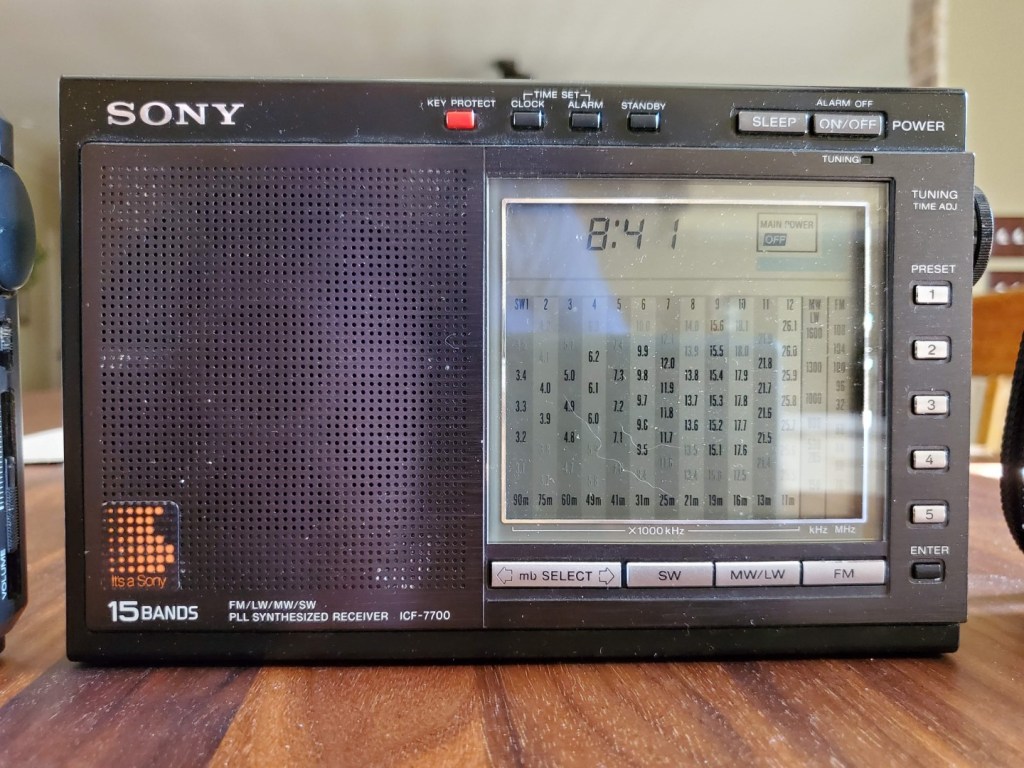
The next model ICF-7700 was still digitally tuned but externally resembled an analog radio with a digital frequency readout added. It sold for $269.95 which is equivalent to $649 in 2021. One may speculate as to why Sony chose to delete the keypad and simulate an analog dial with this model but it seems plausible that they wanted to offer the best of both worlds…a digital readout with analog feel. Perhaps it was designed to be non-intimidating for those who were not comfortable with digital tuning…many users felt they succeeded while others lamented the loss of the keypad. (Interestingly, this faux-analog dial was later copied in 2004 by Degen with their unique DE-1103 which is still available in 2021). The ‘7700 did have a Tuning Knob and looked very much like an analog radio although was PLL digitally tuned with dual conversion and 5 KHz steps. However, the auxiliary antenna jack was gone and there was no automatic scan tuning or SSB. (The radio did come with an AN-6 Compact Antenna which clipped to the whip). You still got a clock with Alarm, Record Out* & Earphone jacks, DC Input jack and a Music/News Tone switch.
Like the ICF-2002 it had two power switches to prevent accidentally turning the radio on. Overall, I found it to be a fun radio to use and its combination of the faux analog display with digital readout makes it very user friendly. Although it is too bad there is no keypad I find the analog-like dial scale an enjoyable way to do general band scanning and there are very few other radios which offer this along with a digital readout.

*One note on each of the above models is that the Record Out jack provides mic level, not the more common line level output. Several Sony portable radios followed this design evidently because they expected you to record on one of their portable recorders which only had a mic input.
Then, in 1998 Sony introduced the ICF-7601 which reverted to a fully analog design, at a lower cost than the preceding two models. It featured a 9 position SW Band Selector (SW-2 – 9) and push buttons to select SW 1, AM and FM. There was no Aux Antenna Jack or Record Output, but there was an Earphone Output, a DC Input and a Music/News Tone Switch. Sony did provide a clip-on SW antenna. After two digital models which were unique at the time, this model was designed like many of the analog multi-band portable which came before. There were no operational surprises with its all-analog design but being dual conversion, it was a step up from many analog portables of the day.
From 1994 – 2000 Sony produced the more deluxe ICF-SW7600G which was upgraded to the ICF-7600GR in 2001, the last radio of the 7600 series which was the least expensive radio of that era to offer Synchronous Detection. A solid performer, it was produced until 2018! Its features were many: Continuous coverage from 150 – 29,999 KHz, 5K/1K Tuning Steps, 100 non-volatile memories, Clock with Timer and Sleep functions, Synchronous Detection, SSB with USB/LSB selection and a Fine-Tuning thumbwheel, a switchable and variable Attenuator, Auto Scan Tuning, Line Out, Earphone and DC In jacks, FM Stereo at the earphone output jack (but strangely not the Line Out jack), Dial Light, Tune Indicator, Lock Key and a Tone Switch. Its Synchronous Detection somewhat set it apart from the competition and at a lower price point than the earlier models due to improvements in technology. The only step backwards was that the Aux Antenna jack no longer worked on FM as on the ICF-2002. Be careful with the whip antenna…it seems many had extremely tight antenna bases which could actually crack the plastic mounting if not handled carefully. But overall, the ICF-7600GR was Sony’s one-two punch representing everything they could squeeze into a package of its size and price.
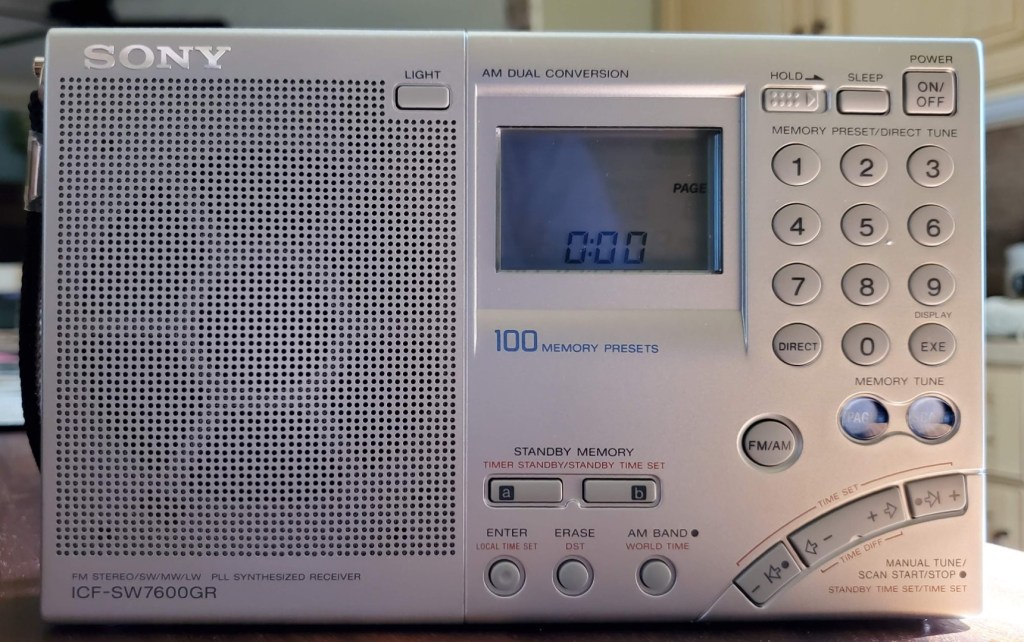
Performance: Here I find I’m a bit at odds with some of the material I’ve researched online about their relative capabilities. Major feature differences notwithstanding, I put the four radios side by side over the course of several weeks, running the radios on battery power and using only their built-in antennas. I scanned all the bands logging signals from faint traces to reasonably listenable signals both day and night and I’ve got to say they performed more similarly than I might have guessed. As I always find, each radio sometimes over or under performed on a given signal, but comparing several pages of logged comparisons they were quite similar in raw sensitivity. There were differences to be sure but it was seldom a night and day difference – rather there were nuanced differences which I will describe.
AM and SW sensitivity and noise floor were very similar on all four radios. I checked readability on extremely weak trace signals as well as background hiss on medium strength signals and the biggest differences were caused by the radios’ different filter characteristics and tonal qualities. The oldest model ICF-2002 had a slightly mellower tonal quality which may be the result of a narrower IF bandwidth filter or simply a less crisp audio characteristic which made noise less objectionable but also slightly reduced readability on the very weakest traces of signals. The ICF-7600GR was the opposite featuring the brightest audio which I generally preferred. The ICF-7700 and ICF-7601 were in between. On just a few signals the ‘7600GR and 7700 had a slightly lower noise floor but this difference was so slight that it was sometimes tough to duplicate. It’s worth noting however that the ICF-2002 and ICF-SW7600GR with their aux antenna inputs might be the best choice for a serious DXer with external antennas although the ‘7600GR’s aux antenna input does not function on FM . On the other hand, the ‘7600GR adds a variable attenuator which is more flexible than the fixed 20 db attenuator on the ‘2002.
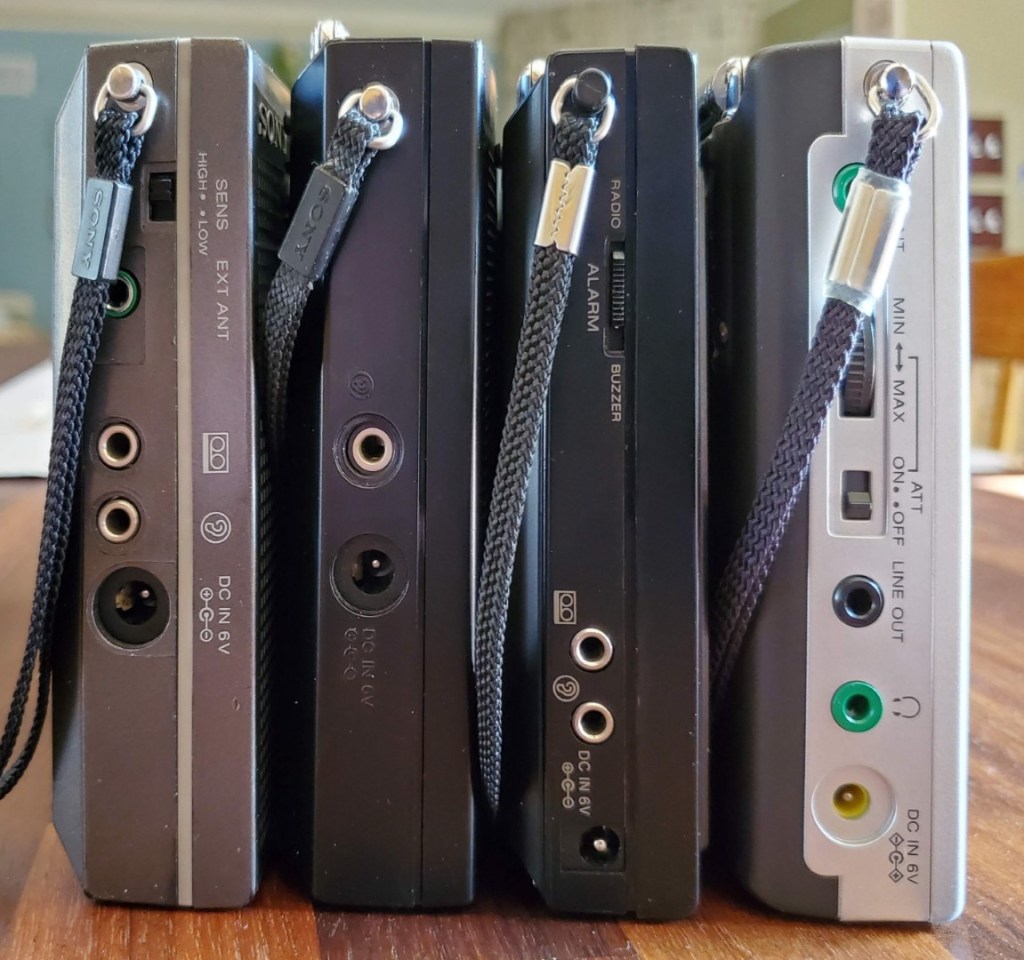
AM and SW Selectivity: All of these radios have a single bandwidth (other than the ‘7600GR which has a narrower SSB filter) which I would judge to be between 4 – 5 KHz and seems like a good compromise between selectivity and audio clarity. With today’s far less crowded SW band conditions you won’t generally have big problems here unless the interfering signal is much stronger than the desired one. The ‘7600GR’s is the only radio in this group to offer two tuning steps of 1 KHz and 5 KHz and it’s synchronous detection, while not the equal of the sync in Sony’s upscale ICF-2010 was still remarkable for this class of equipment and often helped to eliminate a noisy sideband or to reduce the distortion caused by selective fading. (Note: I have read occasional disparaging remarks about the sync, not only in the ‘7600GR but in general, from folks who evidently don’t quite understand what it does. It does not improve every bad signal – it helps in some very specific circumstances, sometimes miraculously, and should be considered a tool which can be used when appropriate and switched off when it is not.).
The Sonys as a group also had decent AGC characteristics and were fairly good at dealing with fluttering, wavering signals.
The ICF-7600GR has muting while tuning which makes band-scanning less pleasant than on some other radios. The other radios in this group have less or no muting in the case of the all analog ICF-7700.
FM: Nothing special here. Most portables of this vintage have poor FM selectivity which I will describe in more detail below.

Comparisons with Modern Portables: OK. These radios perform somewhat similarly overall and were considered top contenders in their day, but I wondered how they might compare with some of today’s modern portable radios in a similar category. Of course, newer designs offer new features and hundreds or thousands of memories, but what about their basic reception? I pulled out a group of reference radios for comparison including several current radios including the Eton Elite Executive, XHDATA D-808, Tecsun PL-990, Tecsun H-501 and Sangean ATS-909X2 and did more side-by-side comparisons.
The biggest differences were on FM as expected where today’s portables are in a completely different category of performance. The Sony’s, like most vintage portables were sensitive enough but have barn-door wide selectivity which renders them much less desirable in most areas with today’s over-crowded FM band. In very remote areas this may not be a problem but in typical locations the modern portables will be able to separate many stations you just won’t find on any of these vintage sets. Also, the newer radios offer FM stereo in earbuds and at their line outs and many have RDS. We’ve come a long way in the past 30-40 years.
On AM and SW however the Sony’s fared much better. On SW they were equally sensitive to weak daytime signals and on AM the Sonys were almost as good as the modern radios. Of course, the modern radios offer multiple bandwidths and had somewhat better audio but overall, as AM/SW portables the Sonys held up very well which is amazing considering their age. Evolving technology does give us more radio for the money in today’s dollars if you remember the adjusted prices of those vintage Sonys – remember that the 1983 ICF-2002 would have cost $787 in 2021.
Special note concerning the ICF-7700. During the years this model was being produced the industry was converting to SME’s – Surface Mount Electrolytic capacitors. SME’s are very small and have tiny contacts which are soldered directly to the PCB with no traditional lead wires. They are a great advancement in miniaturization but when first introduced there were problems – either with the design of the SME’s themselves or with the way they were soldered onto the circuit boards. The general thinking is that they were overheated which damaged them in such a way as to cause them to fail over time. Many old electronics now have failing electrolytics and we customarily replace them with no problems but when an SME fails it can cause catastrophic damage if not caught quickly. They can leak a chemical which actually destroys the circuit board making repairs difficult or impossible. Such failures have also affected other radios of the same era, such as Sony’s ICF-SW77. Indeed, my ‘7700 had its SME’s replaced just in time. A bit of research reveals that the changeover from regular caps to SME’s occurred at serial number 62627 and this is documented in a parts change addendum in Sony’s service manual. So, if you are going to buy an ICF-7700 be sure it is below serial number 62627 or that it has had its SME’s replaced. If you have one with a higher number (mine is in the 10,XXX range) it has probably already failed but even if it still seems OK you should have its SME’s replaced quickly if it’s not already too late.
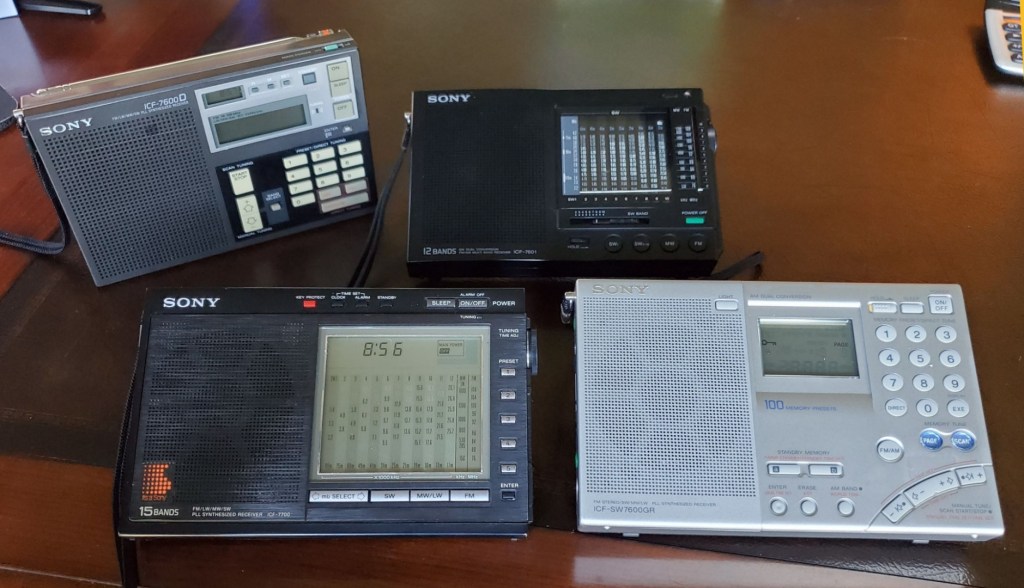
Conclusion: Sony was a leader in the heyday of portable radio development and over the years offered several iconic models such as the hugely innovative and successful ICF-2010 and ICF-6800W among others. To be sure there were a handful of worthy competitors from Panasonic, Grundig and others but as mid-sized portables the 7600 series was long-lived, well-made and offered great performance. These four 7600 series models each represent a unique point in Sony’s evolution and the very fact that they still perform well today is a testament to their quality.
You must be logged in to post a comment.